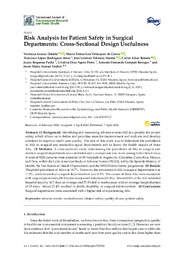Please use this identifier to cite or link to this item:
https://hdl.handle.net/11000/34387Full metadata record
| DC Field | Value | Language |
|---|---|---|
| dc.contributor.author | Aranaz Ostáriz, Verónica | - |
| dc.contributor.author | GEA VELAZQUEZ DE CASTRO, MARÍA TERESA | - |
| dc.contributor.author | López Rodríguez-Arias, Francisco | - |
| dc.contributor.author | Valencia Martín, José Lorenzo | - |
| dc.contributor.author | Aibar Remón, Carlos | - |
| dc.contributor.author | Requena Puche, Juana | - |
| dc.contributor.author | Díaz-Agero Pérez, Cristina | - |
| dc.contributor.author | Compañ Rosique, Antonio F. | - |
| dc.contributor.author | Aranaz Andrés, Jesús María | - |
| dc.contributor.other | Departamentos de la UMH::Patología y Cirugía | es_ES |
| dc.date.accessioned | 2025-01-11T16:15:18Z | - |
| dc.date.available | 2025-01-11T16:15:18Z | - |
| dc.date.created | 2020-04 | - |
| dc.identifier.citation | Int J Environ Res Public Health . 2020 Apr 7;17(7):2516 | es_ES |
| dc.identifier.issn | 1660-4601 | - |
| dc.identifier.issn | 1661-7827 | - |
| dc.identifier.uri | https://hdl.handle.net/11000/34387 | - |
| dc.description.abstract | Identifying and measuring adverse events (AE) is a priority for patient safety, which allows us to define and prioritise areas for improvement and evaluate and develop solutions to improve health care quality. The aim of this work was to determine the prevalence of AEs in surgical and medical-surgical departments and to know the health impact of these AEs. (2) Methods: A cross-sectional study determining the prevalence of AEs in surgical and medical-surgical departments was conducted and a comparison was made among both clinical areas. A total of 5228 patients were admitted in 58 hospitals in Argentina, Colombia, Costa Rica, Mexico, and Peru, within the Latin American Study of Adverse Events (IBEAS), led by the Spanish Ministry of Health, the Pan American Health Organization, and the WHO Patient Safety programme. (3) Results: The global prevalence of AEs was 10.7%. However, the prevalence of AEs in surgical departments was 11.9%, while in medical-surgical departments it was 8.9%. The causes of these AEs were associated with surgical procedures (38.6%) and nosocomial infections (35.4%). About 60.6% of the AEs extended hospital stays by 30.7 days on average and 25.8% led to readmission with an average hospitalisation of 15 days. About 22.4% resulted in death, disability, or surgical reintervention. (4) Conclusions: Surgical departments were associated with a higher risk of experiencing AEs. | es_ES |
| dc.format | application/pdf | es_ES |
| dc.format.extent | 16 | es_ES |
| dc.language.iso | eng | es_ES |
| dc.publisher | Board | es_ES |
| dc.rights | info:eu-repo/semantics/openAccess | es_ES |
| dc.rights.uri | http://creativecommons.org/licenses/by-nc-nd/4.0/ | * |
| dc.rights.uri | http://creativecommons.org/licenses/by-nc-nd/4.0/ | * |
| dc.subject | adverse events | es_ES |
| dc.subject | medical errors | es_ES |
| dc.subject | clinical safety | es_ES |
| dc.subject | quality of care | es_ES |
| dc.subject | patient safety | es_ES |
| dc.title | Risk Analysis for Patient Safety in Surgical Departments: Cross-Sectional Design Usefulness | es_ES |
| dc.type | info:eu-repo/semantics/article | es_ES |
| dc.relation.publisherversion | https://doi.org/10.3390/ijerph17072516 | es_ES |

View/Open:
_Risk Analysis for Patient Safety in Surgical Departments Cross_Sectional Design Usefulness.pdf
623,33 kB
Adobe PDF
Share:
.png)
